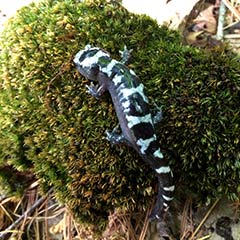
Marbled salamander
Marbled Salamanders
Returning Marbled Salamanders to a Former Home in Massachusetts
Working together with the Massachusetts Division of Fisheries and Wildlife, Medford High School, and the Friends of the Fells, we've begun to reintroduce marbled salamanders to one of their most important former homes in northeastern Massachusetts, the Middlesex Fells. In 2016, we released our first group of young marbled salamanders in the Fells, possibly the first members of their species to occupy this area in 80 years.
For the length of this program, each year, under the guidance of the Massachusetts Natural Heritage and Endangered Species Program, we safely remove newly-hatched marbled salamander larvae from winter-cold vernal pools in western Massachusetts, raise the aquatic larvae through their transformation into air-breathing juvenile salamanders, and release them near suitable vernal pools in the Middlesex Fells. We collaborate with local area schools to raise the salamanders. Unlike Blanding’s turtles, however, our headstarted marbled salamanders are far too small to be radio-tracked and there isn't suitable technology to track them as they seek out suitable forest habitat and hopefully mature into adults in two- to five-years time.
Additionally, in partnership with the Massachusetts Division of Fisheries and Wildlife, the Massachusetts Department of Conservation and Recreation, and others, we'll continue to gather baseline data on marbled salamanders at the Western Massachusetts site. In the next few years, we hope to map out breeding sites used by the salamanders in the Fells, document whether cohorts of larvae survive to metamorphosis, and look for changes in the population over time.
In the News:
- Rare salamanders hatch for the first time in almost a century in the Middlesex Fells, WBUR
- "New life for marbled salamanders in the Fells," The Boston Globe



